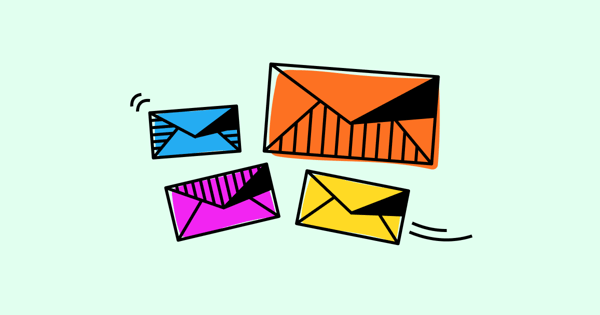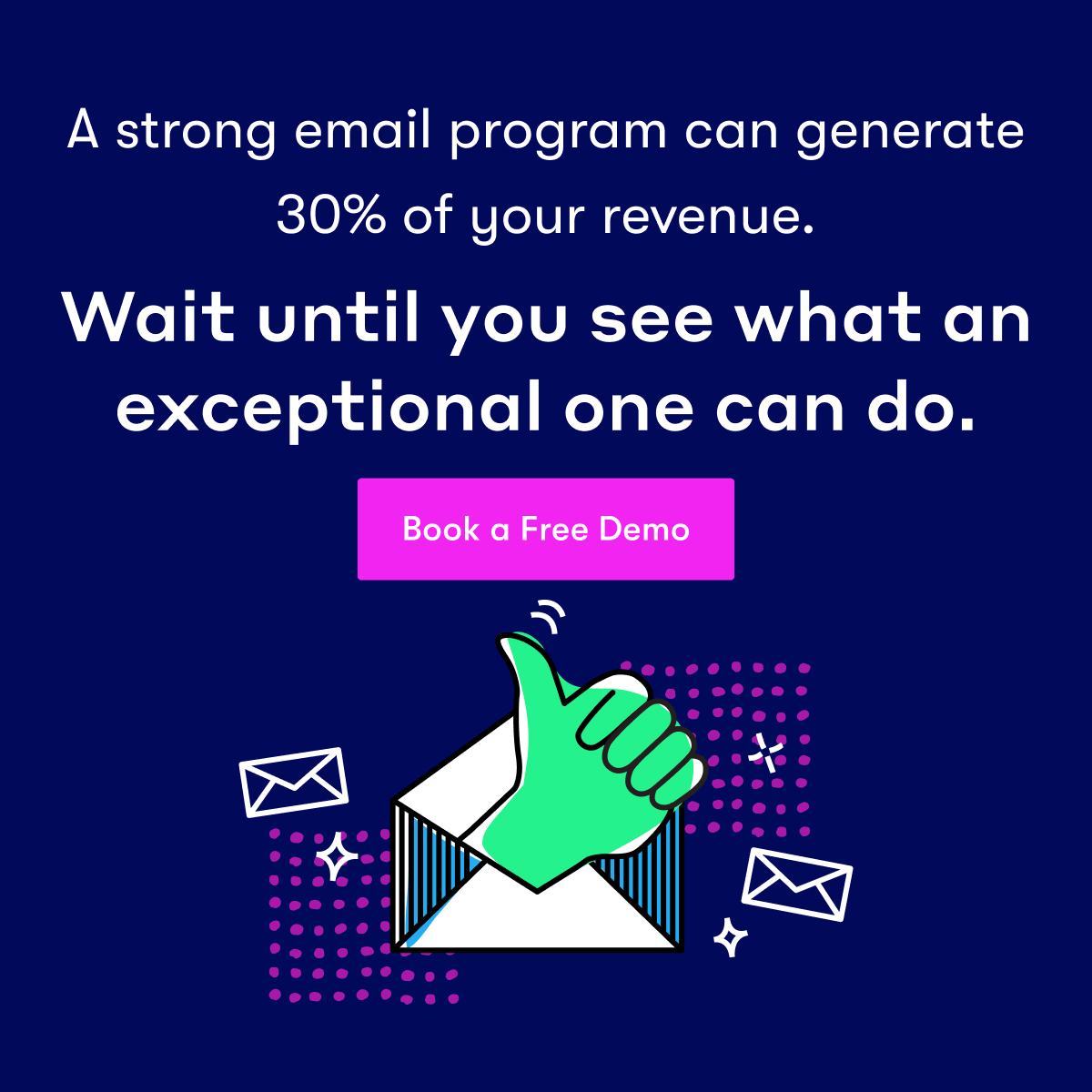It’s a well-known feeling among marketers… You’re trying to write an email campaign for our email list but you just can’t seem to find the right angle.
If this sounds familiar—keep reading.
Today, marketers struggle to write email copy that gets their emails opened and invites readers to take action.
The truth is…
Email copywriting isn’t just about the subject line…
It’s not just about the call to action…
And it’s not just about the copy…
It’s about all of it, and creating emails that function as automated selling machines from the moment you click send.
And that’s what I’m going to show you today: how to write effective emails that resonate with your audience that drive them to take action—meaning more money in the bank for you.
5 Email Copywriting Tips You Need to Master
1. Align Your Body Copy With Your Subject Line
A good email subject line goes beyond the typical clickbait.
It gives your reader a preview of what they can expect to find in the email when they open it.
Here’s another way to look at it:
Look at your subject line as a promise…
…and then fulfill that promise in your email copy.
(You don’t want to make a promise you can’t keep).
This doesn’t mean you can’t get creative with your subject line and provoke curiosity.
Here’s an example from Beardbrand:

They promise their reader the secret to the perfect mustache curl (I don’t have a mustache, but I still opened this email out of curiosity).
When reading this subject line, you expect to find the secret in the email, and Beardbrand delivers:
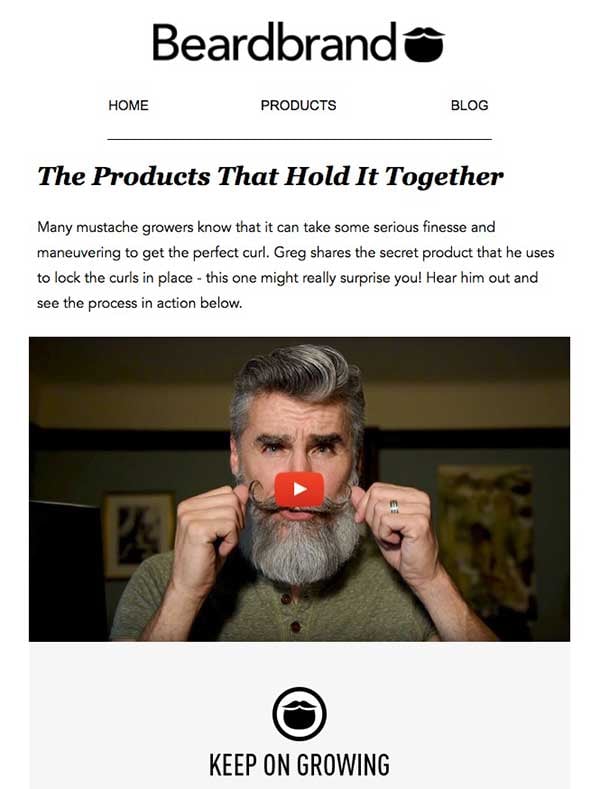
Delivering on your promise creates trust, and readers know that when they open an email from you (because the subject line encouraged them to), they know the content of the email will deliver on the promise made in the subject line, and they’re more likely to open your emails.
2. Use Actionable Language
Your emails all have ONE purpose no matter who you are or who you’re writing to:
To get people to take action!
It’s the single most important thing for any business looking to drive engagement and revenue.
If you don’t get people to act on your emails, you’re doing something wrong.
How to Get Your Readers to Take Action
You need to tell people what to do, and you need to do it more than once throughout your email copy.
Email copywriting is different from writing a blog post, for instance, because you have to invite people to take TWO actions::
- They need to open your email, and
- they need to click-through to your target page.
That’s why it’s important that email copywriting isn’t limited to the email copy itself. It includes everything from the subject line, to your call-to-action (CTA), and your PS.
When it comes to the copy of your email, there are many different ways to write and there’s no one way of doing it.
Email copywriting has been (and still is for many) about writing a short email where each sentence has earned its place and supports the CTA of the email.
However, something many marketers forget is that there’s a way to sell without making every sentence a sales pitch…
The concept of storytelling isn’t new, and you’re probably already doing it if you’re writing blog posts or other types of long-form content.
You can use storytelling in your emails, too, making the content of your emails the value, and your CTA the “second” value, almost like a PS.
The idea here is that if your emails are valuable and relevant to your audience, they’re more likely to click your CTA, even though it isn’t the focus of the email.
A great example is Ben Settle, who sends an email to his prospects EVERY day with the same CTA to subscribe to his physical newsletter “Email Players Newsletter”, but with a different story each day.
Ben uses the concept of “infotainment” to promote his product, and his purpose is to get people addicted to his emails—more than he wants them to buy his product because he believes the first matters most:
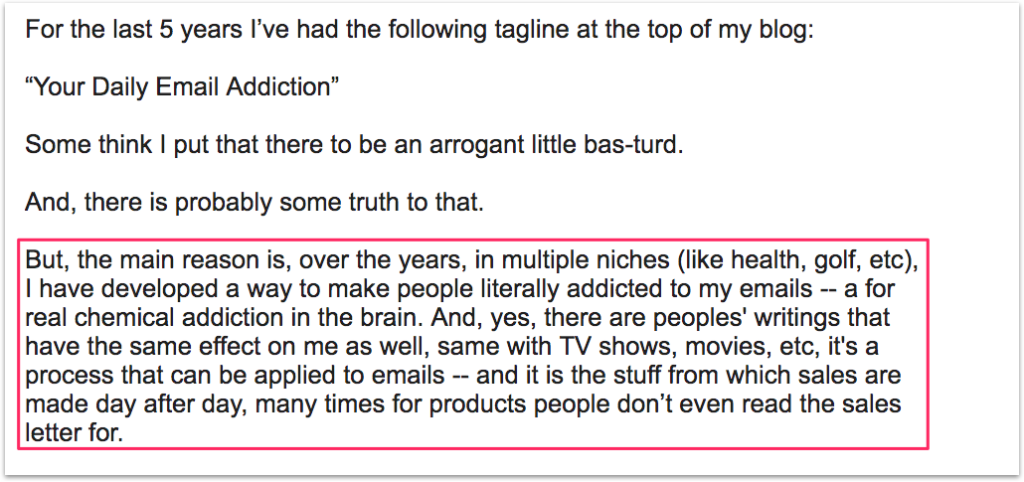
Here’s a recent example:
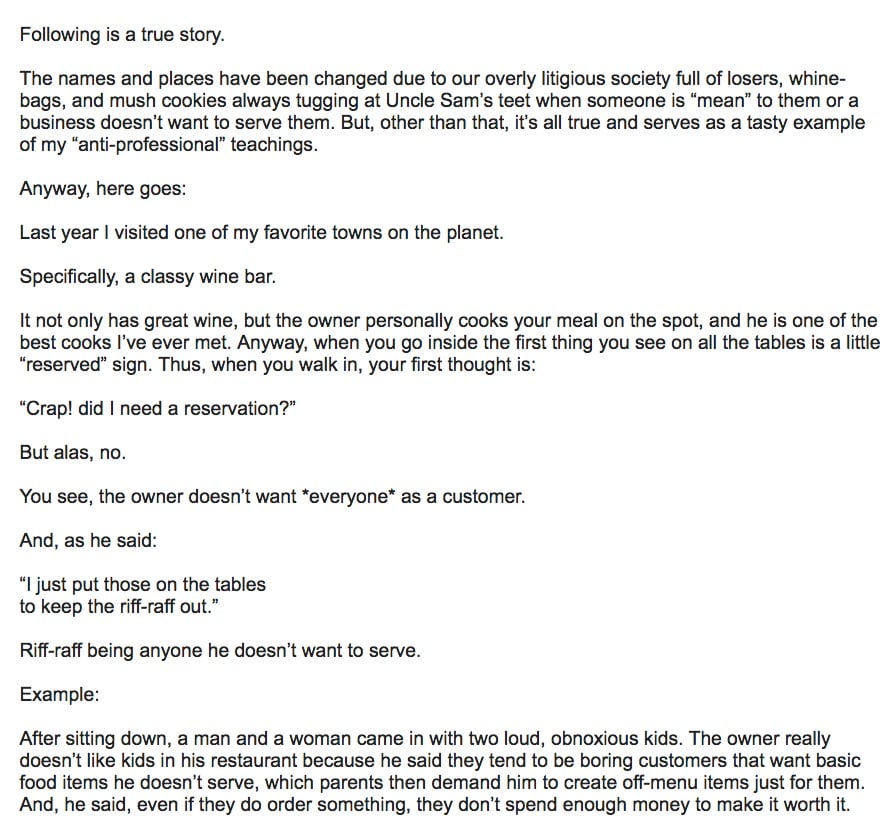
He shares a story that’s seemingly irrelevant to his product but evokes curiosity in his readers.
He then ends the email by establishing a connection between the story and the product and creates a relevant call to action.
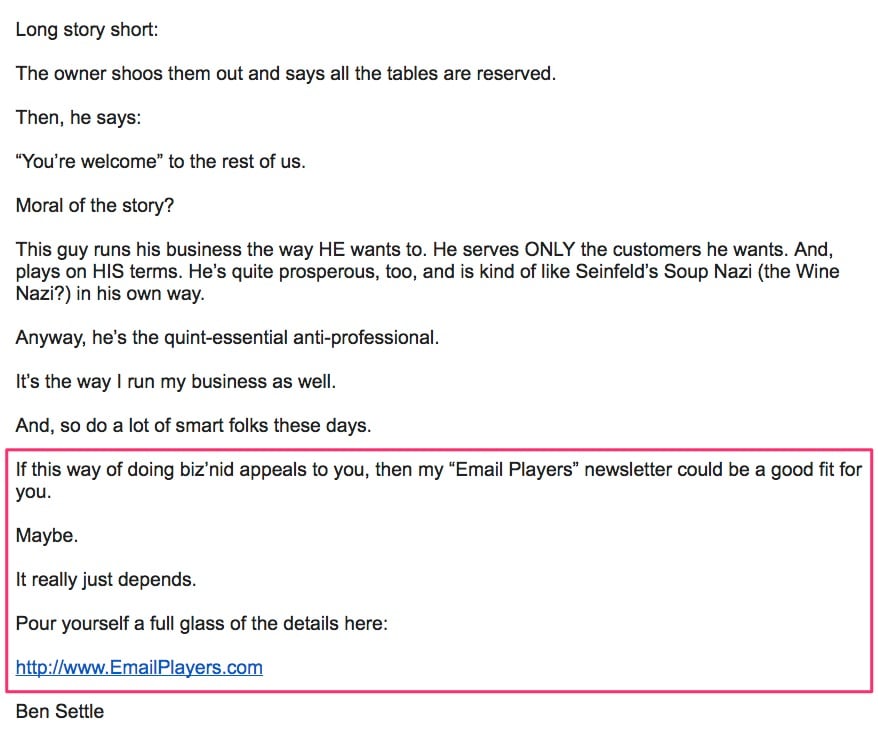
He’s not pushing for a sale but instead encourages his readers to check it out and see if it’s relevant to them (and if they’re smart marketers, it probably is).
Don’t Yell at Your Prospects
Now, you might have noticed how I’ve CAPITALIZED certain words and phrases in this post to emphasize a point. But be careful when you do it in your emails.
This is another big difference between writing a blog post and email copywriting.
You have limited space to work with when writing emails, and you need to get to the point a lot faster than you do with other types of content.
It can be tempting to capitalize your CTA or even whole sentences in your email that you don’t want people to overlook. But the problem is that it can easily appear as if you’re yelling at people—and no one likes to be yelled at.
Let me illustrate:
“SHOP THE LATEST DRESSES TODAY”
Vs.
“Shop the latest dresses today”
How did the first sentence sound in your head compared to the second?
A bit louder and aggressive, right?
I’m not saying capitalizing certain words won’t work because sometimes it can, but be careful how you use it.
Here’s a great example from an email I got from Brian Dean:

Here the capitalization is used to emphasize the word and its meaning, and because only the one word in the sentence is capitalized, it doesn’t feel like I’m being yelled at.
As a rule of thumb, you should refrain from capitalizing entire sentences, and stick to single words that help emphasize your point.
3. Establish Relevancy
With the massive amount of emails sent every day, you should be grateful whenever a subscriber opens your email.
With that said, your emails MUST be relevant to the individual receiver if you want them to keep opening your emails.
In fact, 63% of consumers say they’d think more positively of a brand if it gave them content that was more valuable, interesting or relevant.
You only have a few seconds to convince your reader that your email is worth their time, which is why you need to establish relevance right away and meet them where they are in the buyer’s journey.
To quote Robert Collier: “Always enter the conversation already occurring in the customer’s mind.”
If a potential customer abandons their cart, you need to send an email and try to convince them to complete their purchase.
Eliminate any questions or concerns the reader might have by addressing them in your email copy.
Why did they leave their cart?
Perhaps the price was too high, or they didn’t have the time to finish. Whatever the reason is, you need to consider it when writing effective emails.
Here’s an example from Casper:
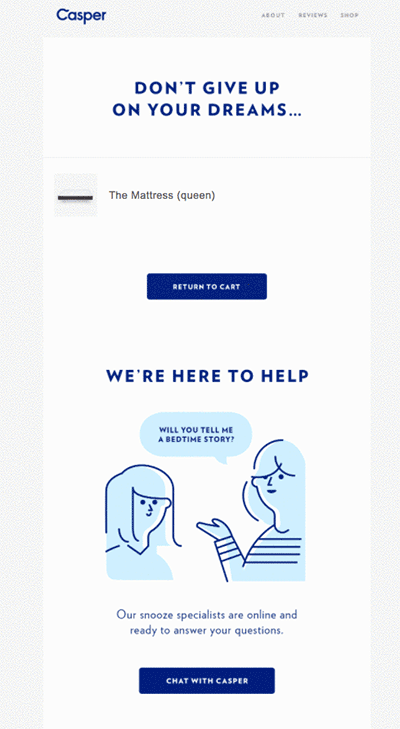
They establish relevancy right away by letting you know you left an item in your cart, and show you which item it is.
Because Casper knows there are several reasons why people abandon their cart, they encourage a dialogue to eliminate the obstacles that prevent people from buying.
Sending the right emails to the right prospects at the right time is more important than ever, and the only way to do so is by segmenting your audience into different target groups based on your buyer personas.
4. Personalize
It should no longer come as a surprise that you should personalize your email copy for your receiver.
But what many e-commerce brands don’t realize, is that personalization goes beyond a merge tag with the receiver’s name in the greeting.
I know it’s impossible to write personal emails to every single prospect on your list, but there are a few hacks you can use to make your email copy appear as if it was written for the individual.
Besides the importance of relevance established above, you should always write in the second person.
This means your company is more reader-centric rather than business-centric.
Here’s an example from Curioos:
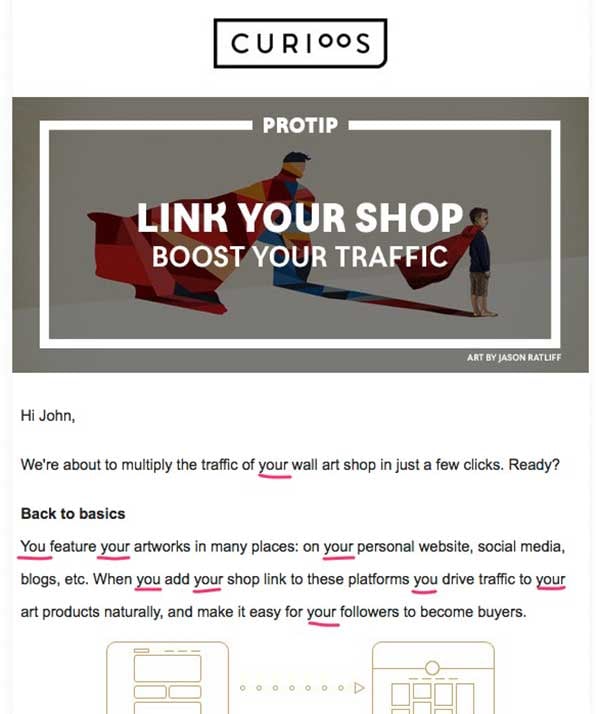
Notice how many times they use the second person in just three sentences…Nine times!
Even though this email is automated, it seems more personal because the focus is on the receiver and describes what’s in it for the receiver (more on this later).
Also, 75% of consumers say they’re more likely to buy from a retailer that recognizes them by name, recommends options based on past purchases, OR knows their purchase history.
Here’s another example from Beardbrand:
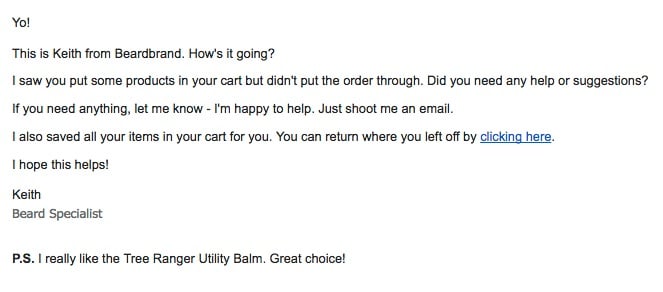
At first glance, there’s not much personalization in this email…But then, notice the PS.
The Tree Ranger Utility Balm was the actual item that was left in the cart!
This not only makes the email personal, it also reinforces the receiver’s choice of product, and makes them more inclined to go back and buy.
There are many ways of writing emails that are personal but doesn’t require hours of work. The more you segment your audience and send trigger based emails, you can automate most of your emails and still keep them personal and relevant.
Personalize your abandoned cart emails by automatically including the image, name, and price of the abandoned item to refresh the shopper's memory.
5. Focus on Benefits Over Features
How often have you received an email with a description of how awesome a product is and a CTA telling you to buy now?
Maybe you’ve even sent these out yourself?
I have…unfortunately…
Too many businesses focus on explaining and showing new features, new product launches, and so on.
To quote Ramit Sethi: “That’s great for YOU, but how does this help ME?”
That’s the question every prospect asks themselves when receiving an email like that.
Instead, you need to scrap all the egocentric BS (pardon my french), and instead focus on the value your potential customers will get from using your product.
What’s the problem your product will help them solve?
Put yourself in the shoes of your target audience, and think about what they’re struggling with or what they want to achieve.
Take this example from Dollar Shave Club:
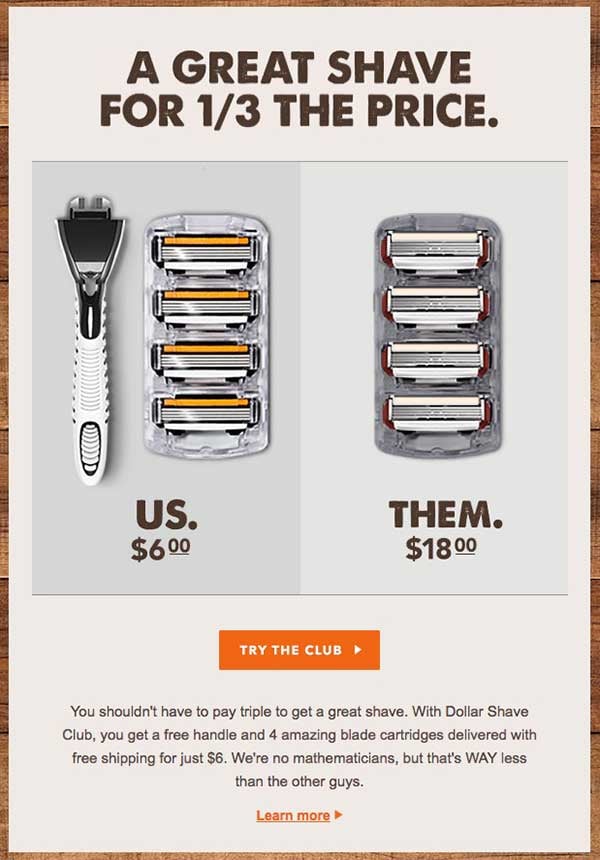
They address the problem right away: Shaving can be a costly affair, and then they provide a solution: The same (or better) quality for a third of competitors’ prices.
It doesn’t have to be more complicated than that.

Don’t Neglect Your Email Copy
Writing compelling email copy isn’t rocket science, but it does require researching your audience and figuring out the writing style and triggers they respond best to.
If you adopt the notion that every word has to earn its way into your email copy, you’ll automatically think more about how you construct your sentences to support the overall message of your email—which will reflect positively on your bottom line.
Start by taking a look at your most recent email campaigns.
What would you have done differently knowing what you know now?
When you know the answer, you’ll know how to write copy for your next email.

